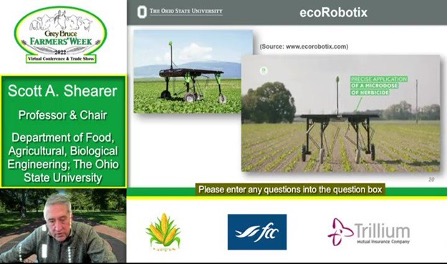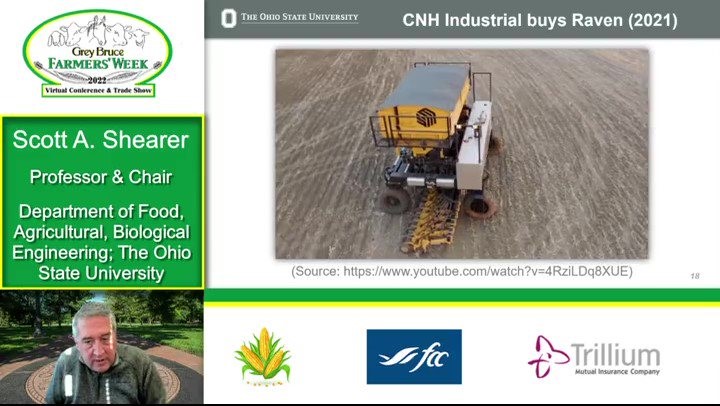Written by: Emily McKague, on behalf of the Georgian Central Regional Communication Coordinator
Scott A. Shearer, a professor and chair at the Ohio State University, sees a very big picture indeed. During this year’s Grey Bruce Farmers’ Week Crops Day, he presented Ag Tech: Disruption or Distraction and left us with many points for mulling on a snowy winter day!
For many years agricultural equipment manufacturers have tended towards producing ever larger machines, in order to cover more ground in a condensed time frame. Shearer’s view of the future actually turns that idea upside down, saying that small autonomous vehicles will solve problems from soil compaction to labour shortages, be more adaptable to changing weather patterns, and more economical to boot! Technology adaptation will bring about changes to machinery ownership and agribusiness structure, and it could all happen within the next decade.
We all understand how fast technology upgrades can move. Within a century our society has gone from driving horse and buggy as the main mode of travel, to being on the cusp of self-driving cars. What seemed futuristic at one time in a Jetson’s cartoon is now plausible and more-than-likely. All the same, to watch videos provided by Shearer with small autonomous vehicle swarms planting crops in a field, or high clearance solar powered sprayers equipped with human-like arms that can identify and spot spray weeds; it was hard to believe that in 10 years’ time they could become the norm.

Scott A. Shearer’s presentation: Ag Tech Disruption or Distraction, Jan. 11, 2022
He noted that challenges such as compaction and shortened planting or harvest windows during wet years can both be solved with smaller vehicles. Traditionally, the larger the equipment, the more one operator could get done in a day. With autonomous vehicles however, no operator needs to be in the cab, and the same vehicle can run 24/7 without break. As weather becomes more severe and unpredictable, using smaller vehicles could open up the planting window—allowing farmers to get on their fields once the surface alone is dry, rather than needing to wait for lower soil levels to be stable for weight bearing with larger equipment.
Automation doesn’t need to be limited to self-driving tractor pulling tillage, planting, or harvest equipment either. Shearer put forward the idea that robotic irrigation systems moving from field to field on their own could replace the capital investment of a stationary centre pivot system. High clearance robotic liquid manure application that puts nutrients directly at the root level would broaden the window of application on crops. In field sensors which stay in the ground season-long and monitor aeration, salinity, fertility, moisture, temperature, and other variables have been developed and are on the market currently.
Just like any other advancement in technology, the machines are not the only things that will change with their adoption. Our systems will adapt and restructure as well. Shearer sees Farming as a Service (FaaS) being the way of the future, with producer ownership of equipment being less and less common. Sabanto Ag is an Illinois company already operating on a FaaS system.
The company has a fleet of small autonomous tractors which run 30 to 40-hour shifts planting soybeans, and they do it more economically than most operations currently can. Sabanto Ag said “As a general rule, machinery costs for a planting operation are $0.25/hp-hr – ours are down to $0.07/hp-hr.” In another example presented by Shearer; an Australian company that leases out autonomous sprayers said that their costs are around $1.00/ac, compared to a typical $7.00-$10.00/ac custom rate. The producer sets the dates that they need their field work done between, and the company does the rest. Again, with smaller equipment, field conditions don’t cause as much of a challenge.
There are many implications that come with the FaaS business model. Farm business retailers would switch from being suppliers to, as Sabanto Ag’s owner puts it: being in the business of “seed installation”. This could be true of fertilizer, chemical, seed, irrigation, manure and more. Rather than purchasing field inputs and keeping them on farm until use, farmers would simply contract their retailer to install the product on the field. There might be no ownership of product until it is in the soil.

Scott A. Shearer’s presentation: Ag Tech Disruption or Distraction, Jan. 11, 2022
As FaaS becomes more popular, equipment ownership by farmers would also decrease. Shearer asked; at what point does purchasing equipment become a risk for obsolescence? If the speed of change and adoption becomes too great, a purchased piece of equipment with a 25-year lifespan might not be practical for use in five years after purchase. Additionally, as technology adoption happens there will be a point where farmers can no longer be economically competitive if they continue to use older equipment. If ‘so-and-so’ can plant, grow, and harvest their field for a fraction of the cost you do, and most of the country is now farming like ‘so-and-so’, you may have the choice to adopt their methods, or get out of the business.
On the flipside of the coin, he sees the move to smaller autonomous equipment leading towards “scale neutrality” where a small farmer can use the same machine as a larger farmer, just with a different number running the fields.
So, what factors will influence whether these technological changes come about? The biggest one is access to rural broadband internet, as all autonomous machines need to collect, analyze, and share information. Not only is coverage an issue, but our upload and download capacity will need to increase dramatically as the amount of data being processed grows. Areas that have the internet services necessary for movement of that information will be the ones where new technology implementation is possible. Areas that don’t, will be held back.
Whatever the speed of development, access, and adoption; it is clear there are big changes coming. We were very grateful to Scott Shearer for taking the time to present on Crops Day, and for sharing with us this big picture of a brand-new world.